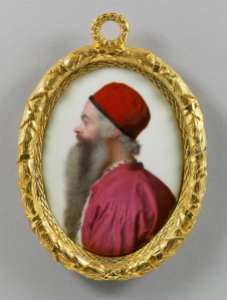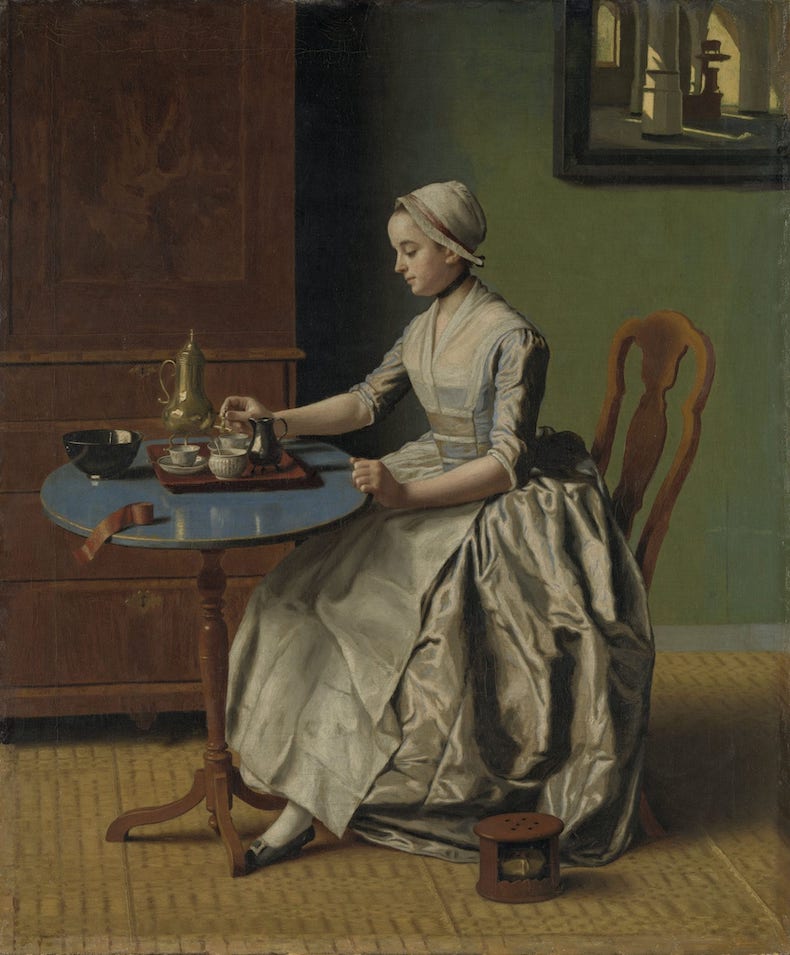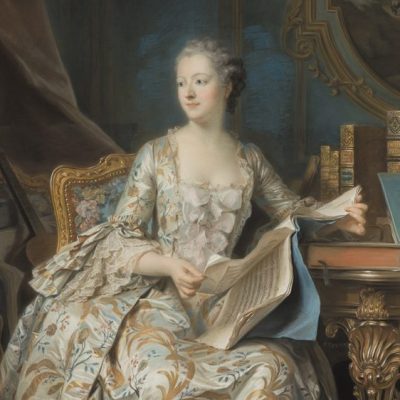In 1754, during a stay with family in Lyon, the Swiss painter Jean-Étienne Liotard gathered six pieces of paper and his pastels. He arranged his niece and great-niece with a mismatched collection of Japanese Imari ware porcelain and a claw-footed coffee pot. The result was a ‘large Conversation Piece […] of his highest finishing’, with which he journeyed to London. In The Lavergne Family Breakfast, arguably his masterpiece, Liotard’s relatives become a mother and child enjoying a morning repast of bread and coffee. The girl, seemingly around five or six and still wearing the previous night’s hair curlers, dunks her bread with vigour into a cup already full to the brim. Her companion conceals any concern she may feel for her daughter’s sleeve, contenting herself with judiciously steadying the saucer.
Arriving in London, Liotard drew immediate attention with his large beard and the distinctive ‘Turkish’ attire he had acquired during a protracted stay in Constantinople. He sold The Lavergne Family Breakfast to his longstanding patron, the Earl of Bessborough, and probably didn’t see the work again until 1772, when he copied it in oil in London. Both versions of the painting remained in private collections for the next two centuries, but in 2019, the pastel was acquired by the National Gallery, where the two versions can now be seen together once more. Though pictures and artefacts provide context and demonstrate Liotard’s interest in portraiture and porcelain, the central ‘spot the difference’ in this small but delightful exhibition demonstrates the often overlooked importance of pastels in the history of Western art. The steep price of 200 guineas that Bessborough paid for the Breakfast reflects both its unusual size – it is just over one metre wide – and the artist’s manifest skill (the porcelain glimmers; blue veins are visible through translucent skin; even the pins securing the apron are faithfully reproduced). However, it also speaks to the esteem in which 18th-century collectors held the medium of which this idiosyncratic and precise painter was, and is, considered a master.
Self Portrait (c. 1753), Jean-Étienne Liotard. Photo: Royal Collection Trust; © His Majesty King Charles III 2023

First mentioned in English in 1628 as ‘Crayon’ or ‘Dry Colours’, pastels grew in stature throughout the 18th century, with practitioners including Rosalba Carriera and John Russell. Though the young and probably posturing Joshua Reynolds sniffed, on Liotard’s arrival in London, that his crayon-pictures were merely ‘what ladies do when they paint for amusement’, the medium was well suited to the tastes and concerns of the period. Pastels were then referred to as ‘paintings’ and hung to compete with oils. This light-reflective medium facilitates precise rendition of detail and texture, making it appropriate for display, and close examination, in small, convivial settings. The velvety pigment never dries but rather clings to the paper, so it is ephemeral – Diderot called it a ‘precious dust’. An unfinished portrait of George Keppel, sent from Geneva to London soon after its production in 1768, preserves Liotard’s anxious inscription asking handlers ‘to please not touch the painting’. Indeed, once on display, a pastel would also dazzle with the reflections on the glazing that enclosed it, a protective measure that was the result of technological developments in glass manufacture.
The Lavergne Family Breakfast (c. 1773), Jean-Étienne Liotard. Photo: courtesy private collection and the National Gallery, London; © private collection

As is clear from a preparatory copy of his most famous pastel, The Chocolate Girl (c. 1744–45) – an astonishing survival – Liotard must have used this glazing when making his copy of the Breakfast, tracing the lines and tones on to thin paper placed directly on the glass. The copy is fastidious: in the pastel, the shine of the porcelain is indicated by wetted globs of pigment, which are substituted with raised impasto in the oil. It is unclear why Liotard sought such precision, though it seems likely he hoped the second picture would repeat the financial success of the original – perhaps capitalising on the dominance of oil paint and painters towards the close of the century (the sneering Reynolds had become ‘Sir Joshua’ in 1769).
At the same time, as is clear from comparing the two versions of the Breakfast, movement between media came naturally to Liotard. The pastel demonstrates what ‘crayon’ can achieve, but Liotard’s Dutch Girl at Breakfast (c. 1756), painted around the same time, deals with similar themes in oil. On the wall behind a young woman pouring coffee, a painting-within-a-painting shows a sunlit church interior. The detail is a tribute to Dutch ‘Golden Age’ artists, whose devotion to realism was necessarily inseparable from the depth and tone facilitated by oil paint. Depth is clearly at issue in the second Breakfast, where the mother’s shadow on the wall is significantly more prominent. However, the main difference between the two is a change in the colour of the porcelain: Liotard used blue smalt in the oil, and it has faded with time to brown. Pastel may be a fugitive medium, but, as this exhibition makes clear, it is much more powerful than it seems.
Dutch Girl at Breakfast (c. 1756) Jean-Étienne Liotard. Photo: © Rijksmuseum, Amsterdam

‘Discover Liotard and the Lavergne Family Breakfast’ is at the National Gallery, London until 3 March 2024.



